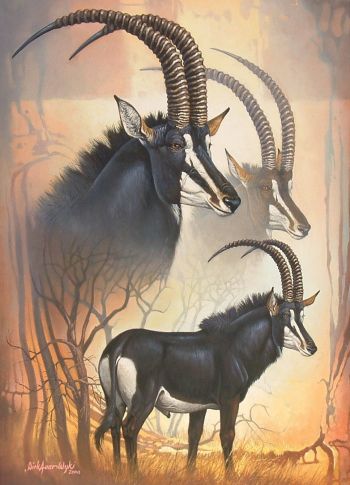Difference between revisions of "Sable Antelope"
Tao alexis (talk | contribs) |
Tao alexis (talk | contribs) |
||
| (32 intermediate revisions by 2 users not shown) | |||
| Line 1: | Line 1: | ||
| − | |||
{{Bestiarychart | {{Bestiarychart | ||
| − | | name = Antelope | + | | name = Sable Antelope |
| − | | species = bovine | + | | species = [[Bovine|bovine]] |
| − | | noapp = | + | | noapp = 4–40 |
| behaviour = herd (loose) | | behaviour = herd (loose) | ||
| − | | range = desert, | + | | range = [[Desert (range)|desert]], [[Steppe (range)|steppe]], [[Woodland (range)|woodland]] |
| size = 4 ft. at shoulder | | size = 4 ft. at shoulder | ||
| weight = 510 lbs. | | weight = 510 lbs. | ||
| Line 12: | Line 11: | ||
| HD = 2 | | HD = 2 | ||
| AP = 8 | | AP = 8 | ||
| − | | THAC0 = | + | | stride = 20 |
| + | | THAC0 = 20 | ||
| hpdie = d10 | | hpdie = d10 | ||
| − | | attack = | + | | attack = 1; [[Horns (attack)|twin horns]] |
| − | | dmg = | + | | dmg = horns (2–8) |
| − | | special = | + | | special = [[Charging|charging]] |
}} | }} | ||
| − | + | '''Sable antelope''' are large hoofed [[Mammal|mammals]] whose range extends from southern Africa to the Indian Subcontinent. They're often confused with the [[Bluebuck Antelope|bluebuck]]. Preferring wooded areas throughout the savanna, sable antelope can also be found in ranges such as the [[Thar Desert|Thar]] or southern [[Arabian Desert|Arabian]] deserts. Their comes from the rich dark colour of their coat; sable antelope skins are prized for use as floor coverings and [[Shield (armour)|shield]] making. | |
| − | + | [[File:Antelope-sable.jpg|left|350px|thumb]] | |
| + | == Behaviour == | ||
| + | Ordinarily docile, these [[Animal|animals]] give ground when approached, keeping a distance of 20-50 [[Combat Hex|hexes]]. If pressed or cornered, they'll fight. A hit with a [[Missile Weapons|missile]] causes the antelope to scream, panicking the herd into a run; when in flight, they reach speeds up to 35 mph. When encountering predators that can outrun them, the herd tightens to confront the threat, with horns outward. If one antelope is [[Stun Lock|stunned]] or [[Death|killed]] of an antelope, the others break, leaving predators to have at their kill. | ||
| − | + | Sable antelopes rut during the late dry season, for 2-3 months, when they're at their most aggressive. Males fight to choose the lead male — though these fights rarely end in injury. During the rutting period, the antelope may '''charge''' aggressively if approached. A hit with the horns causes [[Damage (hit points)|damage]]. | |
| − | When | + | When herds grow larger than 35 to 40 animals, cows and their young will split into two or three different groups, followed thereafter by the males. Each new group is led by one adult bull, who will move with the females. Secondary males keep to themselves as a separate group, about 3-12 in number. |
| − | |||
| − | + | See [[Bestiary|Bestiary]] | |
| − | + | [[Category: Don't Review until 2024]][[Category: Animal Intelligence]] | |
| − | |||
| − | |||
| − | |||
| − | [[Category: | ||
Latest revision as of 23:07, 22 June 2022
| Species | bovine |
| No. Appearing | 4–40 |
| Behaviour | herd (loose) |
| Range | desert, steppe, woodland |
| Size | 4 ft. at shoulder |
| Weight | 510 lbs. |
| Intelligence | 1 |
| Armour Class | 7 |
| Hit Dice | 2 |
| Action Points | 8 |
| Max. Stride | 20 |
| THAC0 | 20 |
| Hp/Die | d10 |
| Attack Forms | 1; twin horns |
| Damage | horns (2–8) |
| Special Attacks | charging |
Sable antelope are large hoofed mammals whose range extends from southern Africa to the Indian Subcontinent. They're often confused with the bluebuck. Preferring wooded areas throughout the savanna, sable antelope can also be found in ranges such as the Thar or southern Arabian deserts. Their comes from the rich dark colour of their coat; sable antelope skins are prized for use as floor coverings and shield making.
Behaviour
Ordinarily docile, these animals give ground when approached, keeping a distance of 20-50 hexes. If pressed or cornered, they'll fight. A hit with a missile causes the antelope to scream, panicking the herd into a run; when in flight, they reach speeds up to 35 mph. When encountering predators that can outrun them, the herd tightens to confront the threat, with horns outward. If one antelope is stunned or killed of an antelope, the others break, leaving predators to have at their kill.
Sable antelopes rut during the late dry season, for 2-3 months, when they're at their most aggressive. Males fight to choose the lead male — though these fights rarely end in injury. During the rutting period, the antelope may charge aggressively if approached. A hit with the horns causes damage.
When herds grow larger than 35 to 40 animals, cows and their young will split into two or three different groups, followed thereafter by the males. Each new group is led by one adult bull, who will move with the females. Secondary males keep to themselves as a separate group, about 3-12 in number.
See Bestiary
